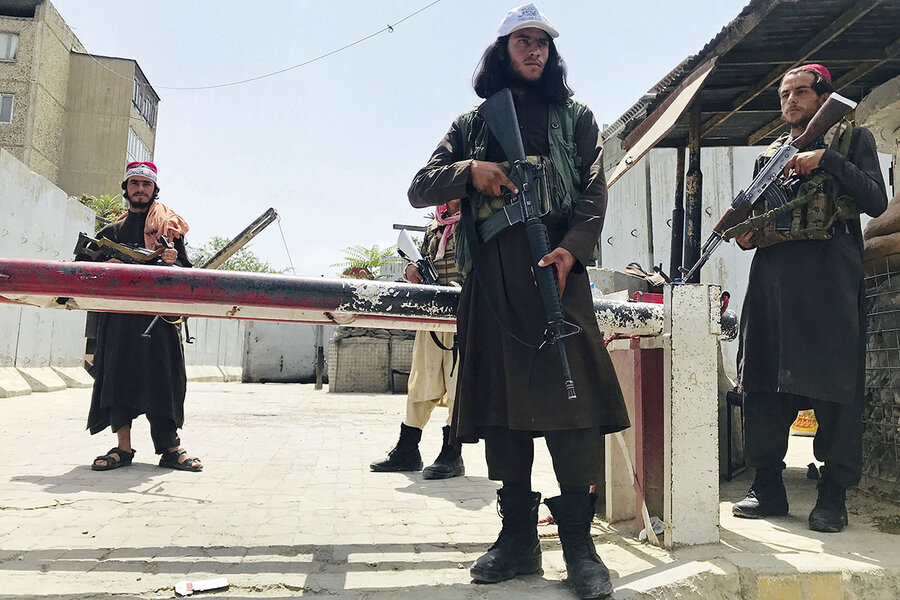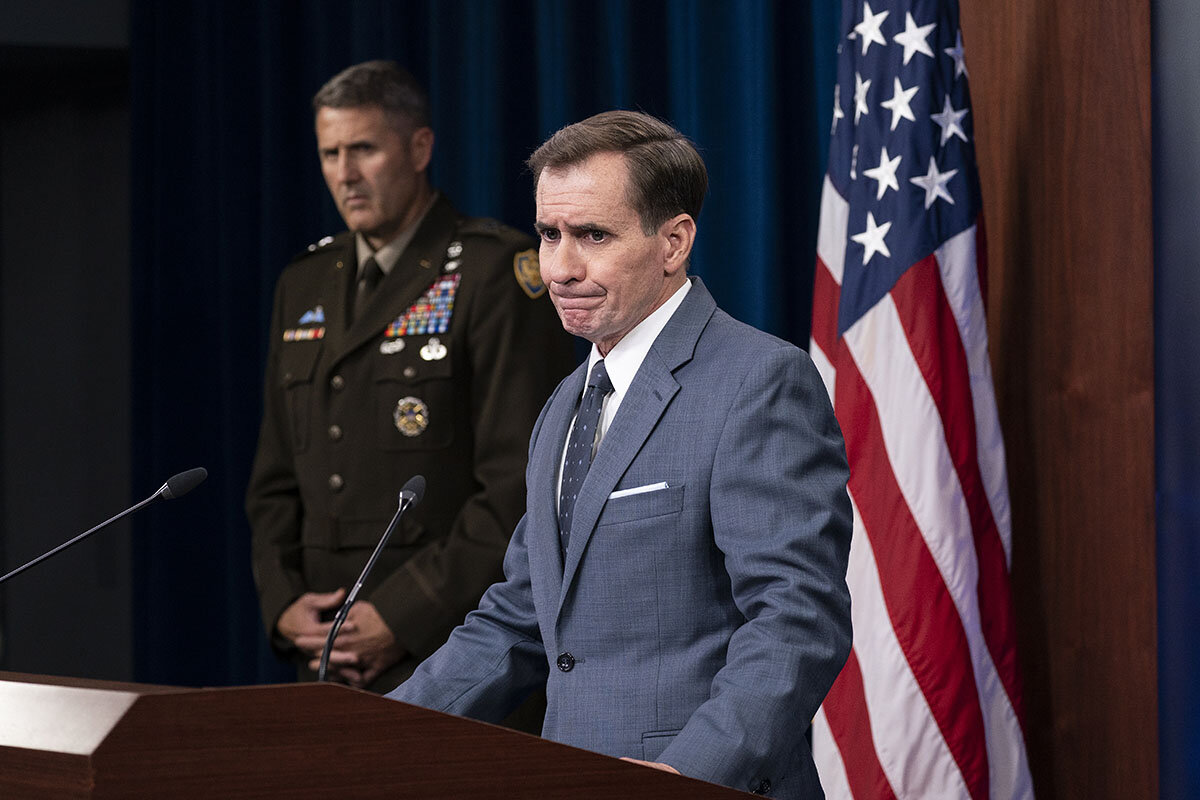Vets see many US failures in Kabul. Military intelligence is just one.
Loading...
While the fall of Kabul to Taliban forces this week produced image after image of heartbreak as Afghans clung to cargo planes and women tried to lift babies over airport barriers in an effort to save them, it was also a baffling theater of the absurd: How could a bunch of guys in flip-flops, with no body armor and nary a fighter jet in sight, have defeated an Afghan army that the United States gave billions upon billions of dollars and thousands of lives to help build?
If the war’s end was a choice between throwing good money after bad and risking more lives lost, or staying longer before the inevitable happened – as the Biden administration and many before it have argued – the speed with which the collapse came seemed, even so, to take everyone’s breath away.
The Pentagon has said that the next two weeks will be focused on evacuating the 10,000 to 15,000 Americans still in the country as well as former Afghan comrades in arms and their families. But honestly assessing what was going on in the field over the past 20 years is crucial to future military efforts, as well as U.S. global leadership. Amid the finger-pointing and blame-dodging for the shocking final week of the war, the initial temptation has been to heap fault on allies left behind. That, some analysts say, ignores U.S. failures of training, lack of understanding about the nation it was trying to build, and wasted resources that ultimately encouraged corruption, to say nothing of the tens of thousands of Afghan lives lost fighting the Taliban.
Why We Wrote This
Honestly assessing what was going on in the field over the past 20 years is crucial to future military efforts, as well as U.S. global leadership.
When one reporter asked Monday if it was a failure of intelligence not to have predicted the quick fall of Kabul, Maj. Gen. William “Hank” Taylor, director of current operations for the chairman of the Joint Chiefs of Staff, could say only that he had no answer to that question.
Pentagon press secretary John Kirby endeavored to come to his aid. “It would certainly be wrong to conclude that the United States military did not view as a distinct possibility that the Taliban could overrun the country.” Still, he added, “One of the things we couldn’t anticipate – and didn’t anticipate – was the degree to which Afghan forces capitulated, sometimes without a fight.”
On this last point, many U.S. veterans beg to differ. There have long been signs that the military training effort wasn’t working, says Jason Dempsey, a former infantryman with two deployments to Afghanistan who is now an adjunct senior fellow at the Center for a New American Security. He recalls, while working with Afghan troops years ago in command and control, “posturing that felt like play-acting.” Behind the scenes, however, “our intel had been cleaning up car bombs sent from Pakistan, and they had 24/7 air support. We declared it a success – but really it was theater, to present the illusion of competence.”
This was a common experience among U.S. and NATO troops, says Vanda Felbab-Brown, senior fellow at the Brookings Institution in Washington. “I know many ground-level U.S. commanders who were training the kandaks [Afghan battalions], who would honestly report the very poor state of the kandak and would be told to give them a higher grade, or it would reflect badly” on the U.S. commander.
“Guys on the ground saw that the training wasn’t working,” says Dr. Dempsey. The one-year tours of duty, however, meant that it was easy to pass the problem along to the next unit. “It’s your incentive to show progress, so you do some small-arms training, some map reading and decide, ‘OK, I did the best I could’; then you leave. What you don’t realize is that the guy before you did the exact same thing, and the guy after you did the exact same thing.”
He has since watched Afghan troops he trained “fold as soon as anyone else.” But it’s hard to blame them, he adds. Troops were isolated and supplies were often snapped up by commanders who sold them for their own gain or survival. “Put yourself in the shoes of an Afghan soldier. There are five to 10 of you sitting in an outpost hours away from resupply, not getting ammunition, not even getting fed consistently,” Dr. Dempsey says. “It doesn’t take much for a local elder to say you’re all alone out here” and convince them to look the other way – or desert.
It also comes after 20 years of warfare in which by far the vast majority of deaths were suffered by the Afghan people. More than 66,000 Afghan National Army and police were killed, in addition to more than 47,000 Afghan civilians, according to Associated Press numbers. And tens of thousands of Afghans supported the U.S. military and NATO allies, with most of them still trapped and waiting for long-promised help.
This week’s debacle was fueled by the absence of solid Afghan leadership from the top down, says Stephen Biddle, who was senior adviser to Gen. Stanley McChrystal in Kabul in 2009 and is now professor of international and public affairs at Columbia University. “There’s a strong tendency in the U.S. and the military to see war as a material enterprise: If you provide enough weapons and field enough soldiers and equipment, then you’ll succeed. But war isn’t engineering and physics – it’s social science.”
In a developing state without a functioning judiciary system to impose consequences for bad behavior, for example, the first order of business for any president or prime minister is to establish a balance of power. “The armed elites, otherwise known as warlords, are pretty satisfied when they are extracting resources roughly equal to their armed following,” says Dr. Biddle. For Afghan presidents, cronyism gave them some measure of control. “The problem is that while it’s good at its primary purpose of maintaining internal political stability, it’s really lousy at defeating an insurgency.”
It’s also detrimental to building an army. “When the boots and equipment you’ve been given are shoddy because of sweetheart contracts, and when you don’t have enough water because it’s been sold on the black market by your commander, it’s much smarter to sit at a checkpoint than to go out and get killed.”
This lack of combat motivation also leads to what’s known in social science circles as “contagion dynamics.” “The U.S. announces it’s getting out, and now it’s a signal to the entire Afghan army and police simultaneously that it’s every man for himself,” Dr. Biddle adds. “When the first units start negotiating with the Taliban, it spreads like wildfire, getting bigger and bigger because every surrender is a signal to the next unit down the line.”
The U.S. fueled the corruption by never turning off the spigot to the massive money flood into the country – the funds kept flowing, and the corruption growing, Dr. Felbab-Brown notes.
As the Taliban stormed into Kabul, they tweeted out photos of the gilded compounds of politically connected warlords – the gaudy excess of the elites reinforcing Taliban talking points among Afghans whose income averages less than $600 a year.
“We were attempting to overcome a core flaw, which was that the Afghan government was seen as predatory,” says Dr. Dempsey. “So us pouring more money into the country means that the Afghan government is more and more seen as a tool of foreign occupiers – the Taliban used that framing to great effect: The Afghan government is seen as less legitimate, and no amount of body armor and weapons can overcome that.”
During Monday’s Pentagon briefing, an Afghan journalist struggled aloud with the loss. “Everybody’s upset – especially women. I forgot my question,” she said. In the midst of tragedy of this scale, “What do you ask?”
She took a stab at a query. Women had “a lot of achievements in Afghanistan. I had a lot of achievements. I [escaped] from the Taliban like 20 years ago; now we go back to the first step again. Do you have any comments regarding our President Ghani,” who fled the country this week for the United Arab Emirates.
Press secretary Kirby said he did not, but he offered that the defeat “is personal for everybody here at the Pentagon. We, too, have invested greatly in Afghanistan and the progress that women and girls have made politically, economically, and socially,” he added. “We do feel that pain that you’re feeling – probably not to the same extent.”
In the weeks ahead, analysts will be grappling with the question of whether there is any good to have come out of America’s longest war. There may be, even if many Americans will not think it was worth the price, says Dr. Biddle. “For starters, we bought 20 years of development for Afghans who wanted a better life. I don’t know how to cost out the benefit of 20 years of opportunity, but Afghanistan is a different place now than it was 20 years ago – and that’s something.”
Going forward, the war must also be a lesson in accountability, say analysts who stress that U.S. commanders were given the “loudest voice” by a Congress much too deferential to military leaders. “We need to get over this idea of water-walking generals,” says Dr. Dempsey, who would like to see hearings on Capitol Hill in which each commander is called to testify in chronological order to answer: “Did you know this was going to fail? When did you know? Were you deluding yourself, or did you actually believe it?”
“What I grapple with is, when does delusion become a lie?” says Dr. Dempsey. “I do believe most of our senior commanders merely deluded themselves, but when you’re driving the war maybe the line between a lie and a delusion is irrelevant – if you’re failing, you’re failing.”
And as the U.S. continues state-building efforts in other countries, it must take Afghanistan as an epic lesson in the damage of too large a spigot of funds with too little accountability among partners “that we’re still not holding to minimal standards of good governance,” Dr. Felbab-Brown says.
Today, however, as the Taliban solidify their control over the country and U.S. troops prepare to pull out for good, “The worst we can do now would be to forget about Afghanistan,” she says. “There is no chance of making them into democratic and women-supporting actors, but we need sustained and painstaking engagement.”
That may look like, “We’ll release this amount of money if you do X and Y, and impose these sanctions if you do Y and Z,” she adds. “We reduce our leverage if they know there’s no chance they’ll get money – no matter how they behave.”








